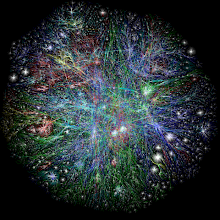
Quite simply, Web 2.0 was the rise of the user. The development of Web 2.0 has significantly changed the way in which we use technology. Rather than technology dictating the extent to which it can be used, as in Web 1.0, the development of Web 2.0 allows the user to lead and drive technology, using it as “a tool for bringing together the small contributions of millions of people and making them matter” (Grossman 2006).
In 2006, Time named the general public, the Web 2.0 user, as its person of the year "for seizing the reins of the global media, for founding and framing the new digital democracy, for working for nothing and beating the pros at their own game" (Grossman 2006). The article modestly captures the progress and advances that Web 2.0 has made compared to Web 1.0, the development of user-led technology and the difference it has made to society and the way we live.
The advances of Web 2.0 and user-led technology are also captured in Mark Pesce's (2007) theory that "the network is us mob, a mass of individuals connected together in ever-evolving configurations of purpose, with ever-expanding capabilities". Web 2.0 has given users the capacity to connect with almost anyone in the world, through a wide variety of networks, with a wide variety of activities, programs, etc. Further to this, Axel Bruns quotes Tim O'Reilly's definition of Web 2.0, stating,
"Web 2.0 is the business revolution in the computer industry caused by the move to the internet as a platform, and an attempt to understand the rules for success on that new platform. Chief among those rules is this: Build applications that harness network effects to get better the more people use them".
A post on Joe Drumgoole's Copacetic blog from May 29, 2006, gives a simple comparison of Web 1.0 and Web 2.0, identifying the key differences and advances in technology between the two. They are:
Web 2.0 vs Web 1.0
- Web 1.0 was about reading, Web 2.0 is about writing
- Web 1.0 was about companies, Web 2.0 is about communities
- Web 1.0 was about client-server, Web 2.0 is about peer to peer
- Web 1.0 was about HTML, Web 2.0 is about XML
- Web 1.0 was about home pages, Web 2.0 is about blogs
- Web 1.0 was about portals, Web 2.0 is about RSS
- Web 1.0 was about taxonomy, Web 2.0 is about tags
- Web 1.0 was about wires, Web 2.0 is about wireless
- Web 1.0 was about owning, Web 2.0 is about sharing
- Web 1.0 was about IPOs, Web 2.0 is about trade sales
- Web 1.0 was about Netscape, Web 2.0 is about Google
- Web 1.0 was about web forms, Web 2.0 is about web applications
- Web 1.0 was about screen scraping, Web 2.0 is about APIs
- Web 1.0 was about dialup, Web 2.0 is about broadband
- Web 1.0 was about hardware costs, Web 2.0 is about bandwidth costs
Image source: http://www.sizlopedia.com/wp-content/uploads/web1_0-vs-web2_0.


